Comparative Framework Research: ECEC in the US and Australia
VerifiedAdded on 2022/09/29
|9
|3384
|29
Report
AI Summary
This report offers a comparative analysis of early childhood education and care (ECEC) frameworks in the United States and Australia. It begins by examining the ECEC landscape in the US, including the absence of a national curriculum and the influence of programs like Head Start and Sesame Street, while also highlighting the impact of capitalism and social inequality. The report then delves into the use of an OECD indicator (Financing) to compare the two countries. The analysis further explores five policy levers from Starting Strong III, including quality goals, curriculum design, teacher qualifications, family engagement, and working conditions, comparing their implementation and effectiveness in both the US and Australia. The report highlights key differences, such as the emphasis on care versus education, the variation in teacher qualifications, and the differences in salary and working conditions. The analysis also examines the different approaches to engaging families and communities in the educational process. Finally, the report provides a comprehensive overview of the strengths and weaknesses of each system, drawing on research and data to support its conclusions.
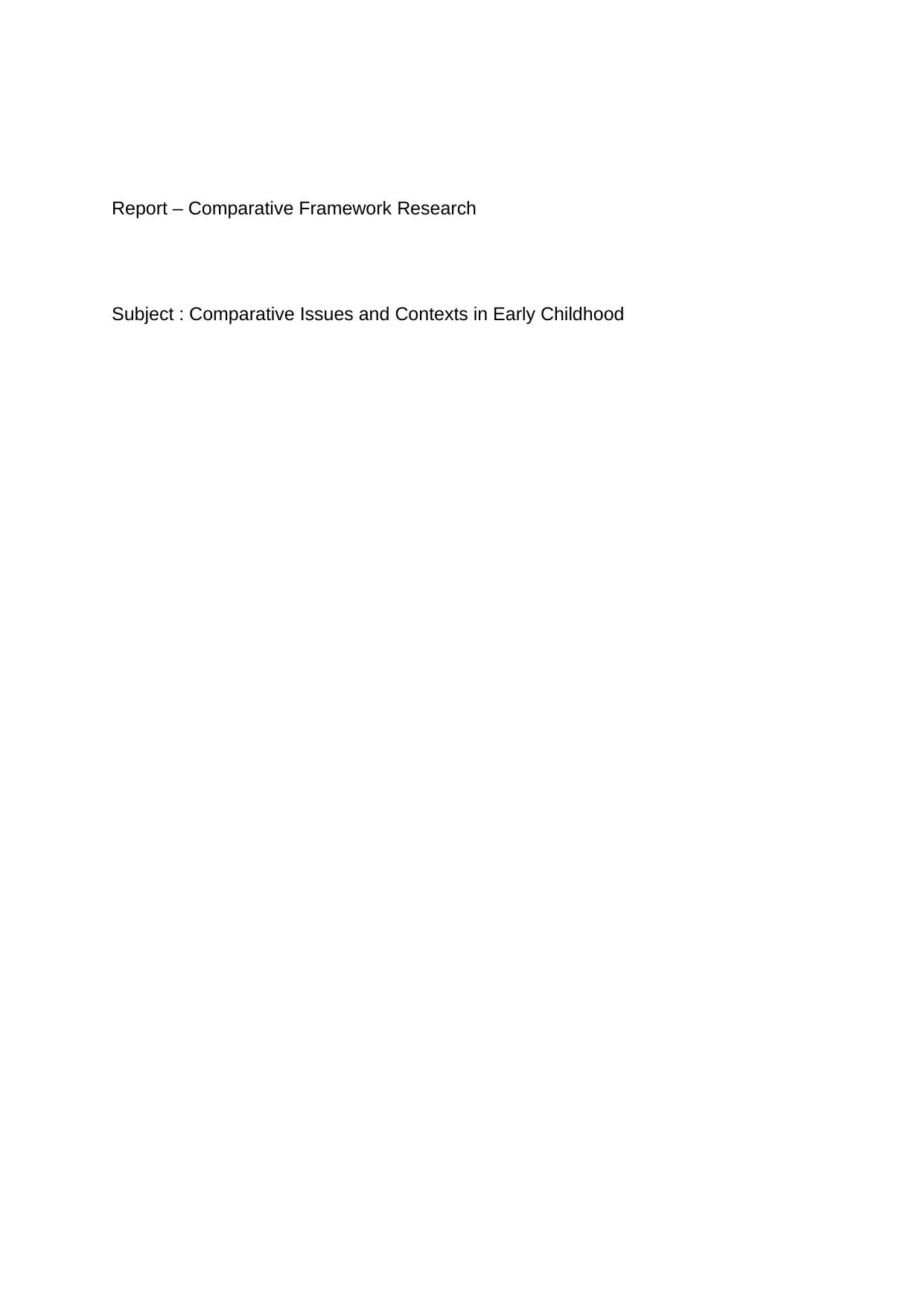
Report – Comparative Framework Research
Subject : Comparative Issues and Contexts in Early Childhood
Subject : Comparative Issues and Contexts in Early Childhood
Paraphrase This Document
Need a fresh take? Get an instant paraphrase of this document with our AI Paraphraser
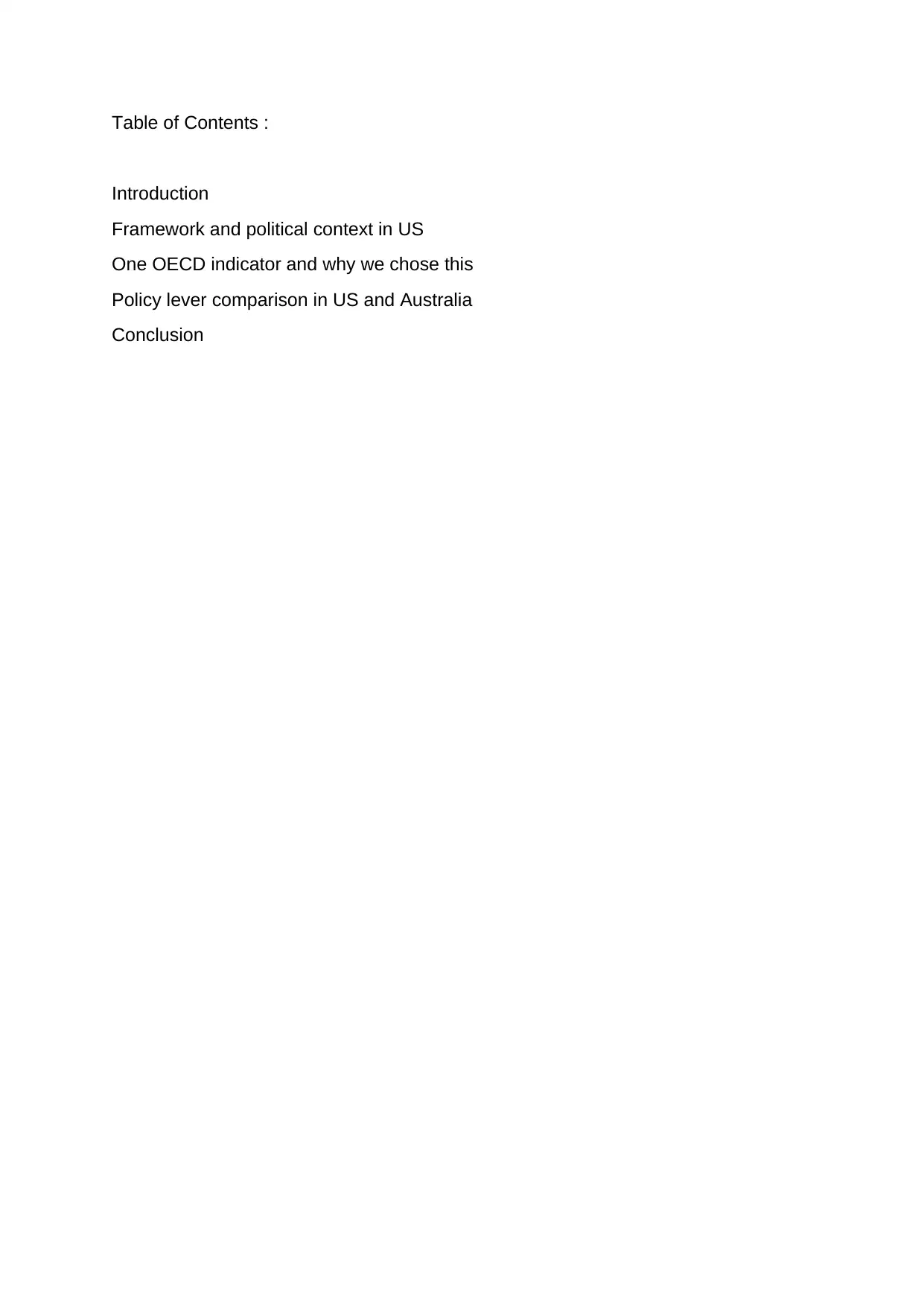
Table of Contents :
Introduction
Framework and political context in US
One OECD indicator and why we chose this
Policy lever comparison in US and Australia
Conclusion
Introduction
Framework and political context in US
One OECD indicator and why we chose this
Policy lever comparison in US and Australia
Conclusion
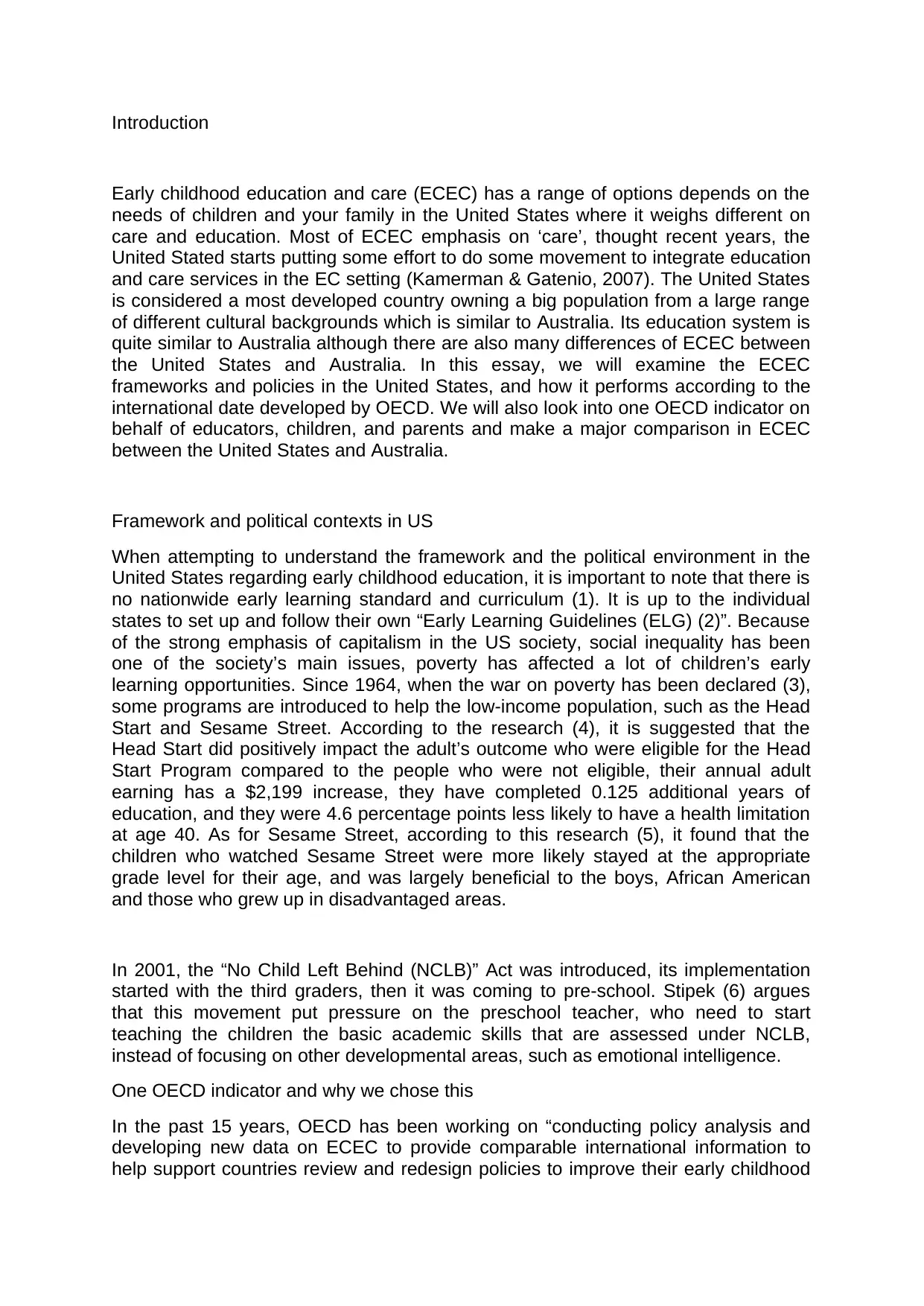
Introduction
Early childhood education and care (ECEC) has a range of options depends on the
needs of children and your family in the United States where it weighs different on
care and education. Most of ECEC emphasis on ‘care’, thought recent years, the
United Stated starts putting some effort to do some movement to integrate education
and care services in the EC setting (Kamerman & Gatenio, 2007). The United States
is considered a most developed country owning a big population from a large range
of different cultural backgrounds which is similar to Australia. Its education system is
quite similar to Australia although there are also many differences of ECEC between
the United States and Australia. In this essay, we will examine the ECEC
frameworks and policies in the United States, and how it performs according to the
international date developed by OECD. We will also look into one OECD indicator on
behalf of educators, children, and parents and make a major comparison in ECEC
between the United States and Australia.
Framework and political contexts in US
When attempting to understand the framework and the political environment in the
United States regarding early childhood education, it is important to note that there is
no nationwide early learning standard and curriculum (1). It is up to the individual
states to set up and follow their own “Early Learning Guidelines (ELG) (2)”. Because
of the strong emphasis of capitalism in the US society, social inequality has been
one of the society’s main issues, poverty has affected a lot of children’s early
learning opportunities. Since 1964, when the war on poverty has been declared (3),
some programs are introduced to help the low-income population, such as the Head
Start and Sesame Street. According to the research (4), it is suggested that the
Head Start did positively impact the adult’s outcome who were eligible for the Head
Start Program compared to the people who were not eligible, their annual adult
earning has a $2,199 increase, they have completed 0.125 additional years of
education, and they were 4.6 percentage points less likely to have a health limitation
at age 40. As for Sesame Street, according to this research (5), it found that the
children who watched Sesame Street were more likely stayed at the appropriate
grade level for their age, and was largely beneficial to the boys, African American
and those who grew up in disadvantaged areas.
In 2001, the “No Child Left Behind (NCLB)” Act was introduced, its implementation
started with the third graders, then it was coming to pre-school. Stipek (6) argues
that this movement put pressure on the preschool teacher, who need to start
teaching the children the basic academic skills that are assessed under NCLB,
instead of focusing on other developmental areas, such as emotional intelligence.
One OECD indicator and why we chose this
In the past 15 years, OECD has been working on “conducting policy analysis and
developing new data on ECEC to provide comparable international information to
help support countries review and redesign policies to improve their early childhood
Early childhood education and care (ECEC) has a range of options depends on the
needs of children and your family in the United States where it weighs different on
care and education. Most of ECEC emphasis on ‘care’, thought recent years, the
United Stated starts putting some effort to do some movement to integrate education
and care services in the EC setting (Kamerman & Gatenio, 2007). The United States
is considered a most developed country owning a big population from a large range
of different cultural backgrounds which is similar to Australia. Its education system is
quite similar to Australia although there are also many differences of ECEC between
the United States and Australia. In this essay, we will examine the ECEC
frameworks and policies in the United States, and how it performs according to the
international date developed by OECD. We will also look into one OECD indicator on
behalf of educators, children, and parents and make a major comparison in ECEC
between the United States and Australia.
Framework and political contexts in US
When attempting to understand the framework and the political environment in the
United States regarding early childhood education, it is important to note that there is
no nationwide early learning standard and curriculum (1). It is up to the individual
states to set up and follow their own “Early Learning Guidelines (ELG) (2)”. Because
of the strong emphasis of capitalism in the US society, social inequality has been
one of the society’s main issues, poverty has affected a lot of children’s early
learning opportunities. Since 1964, when the war on poverty has been declared (3),
some programs are introduced to help the low-income population, such as the Head
Start and Sesame Street. According to the research (4), it is suggested that the
Head Start did positively impact the adult’s outcome who were eligible for the Head
Start Program compared to the people who were not eligible, their annual adult
earning has a $2,199 increase, they have completed 0.125 additional years of
education, and they were 4.6 percentage points less likely to have a health limitation
at age 40. As for Sesame Street, according to this research (5), it found that the
children who watched Sesame Street were more likely stayed at the appropriate
grade level for their age, and was largely beneficial to the boys, African American
and those who grew up in disadvantaged areas.
In 2001, the “No Child Left Behind (NCLB)” Act was introduced, its implementation
started with the third graders, then it was coming to pre-school. Stipek (6) argues
that this movement put pressure on the preschool teacher, who need to start
teaching the children the basic academic skills that are assessed under NCLB,
instead of focusing on other developmental areas, such as emotional intelligence.
One OECD indicator and why we chose this
In the past 15 years, OECD has been working on “conducting policy analysis and
developing new data on ECEC to provide comparable international information to
help support countries review and redesign policies to improve their early childhood
⊘ This is a preview!⊘
Do you want full access?
Subscribe today to unlock all pages.

Trusted by 1+ million students worldwide
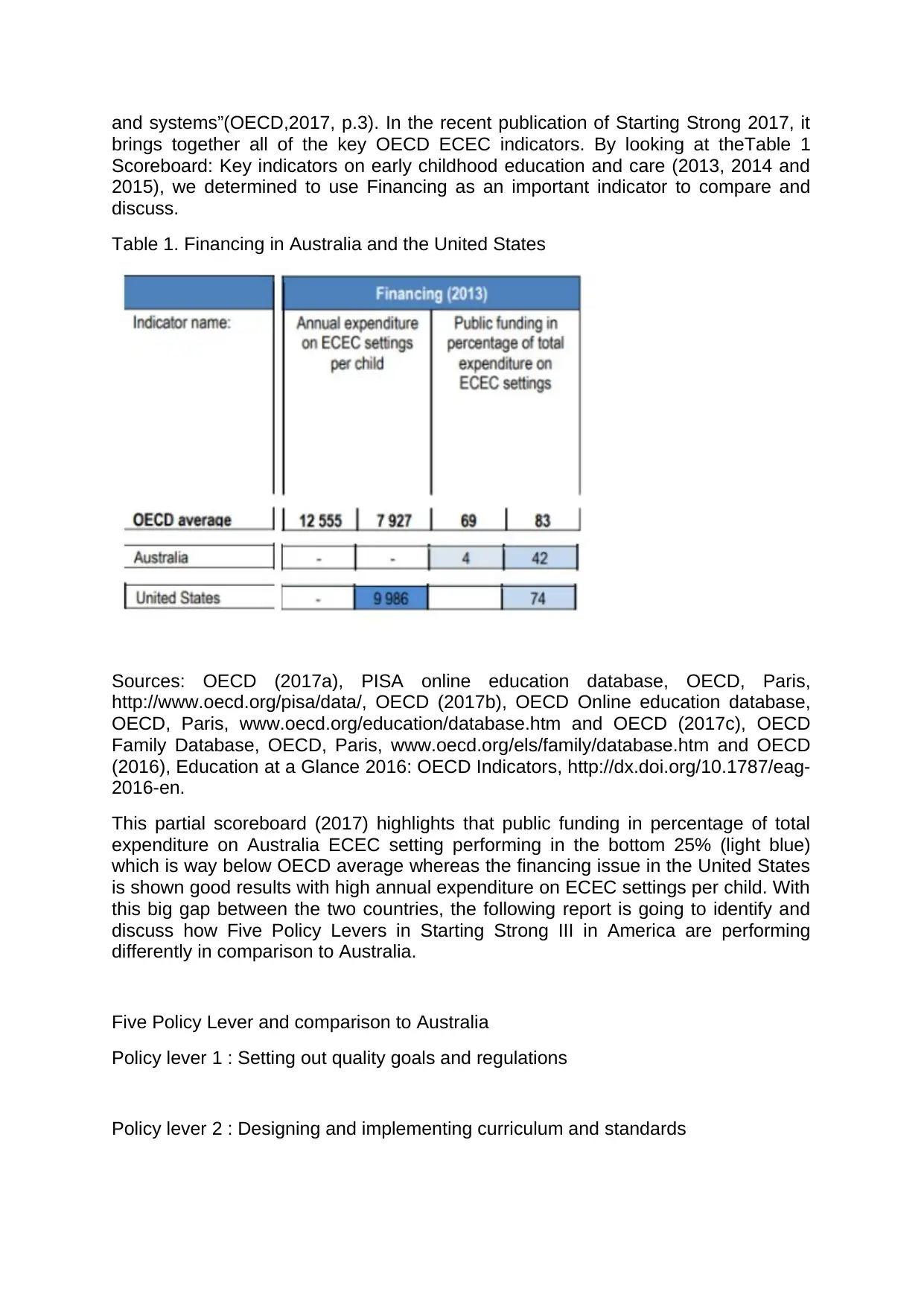
and systems”(OECD,2017, p.3). In the recent publication of Starting Strong 2017, it
brings together all of the key OECD ECEC indicators. By looking at theTable 1
Scoreboard: Key indicators on early childhood education and care (2013, 2014 and
2015), we determined to use Financing as an important indicator to compare and
discuss.
Table 1. Financing in Australia and the United States
Sources: OECD (2017a), PISA online education database, OECD, Paris,
http://www.oecd.org/pisa/data/, OECD (2017b), OECD Online education database,
OECD, Paris, www.oecd.org/education/database.htm and OECD (2017c), OECD
Family Database, OECD, Paris, www.oecd.org/els/family/database.htm and OECD
(2016), Education at a Glance 2016: OECD Indicators, http://dx.doi.org/10.1787/eag-
2016-en.
This partial scoreboard (2017) highlights that public funding in percentage of total
expenditure on Australia ECEC setting performing in the bottom 25% (light blue)
which is way below OECD average whereas the financing issue in the United States
is shown good results with high annual expenditure on ECEC settings per child. With
this big gap between the two countries, the following report is going to identify and
discuss how Five Policy Levers in Starting Strong III in America are performing
differently in comparison to Australia.
Five Policy Lever and comparison to Australia
Policy lever 1 : Setting out quality goals and regulations
Policy lever 2 : Designing and implementing curriculum and standards
brings together all of the key OECD ECEC indicators. By looking at theTable 1
Scoreboard: Key indicators on early childhood education and care (2013, 2014 and
2015), we determined to use Financing as an important indicator to compare and
discuss.
Table 1. Financing in Australia and the United States
Sources: OECD (2017a), PISA online education database, OECD, Paris,
http://www.oecd.org/pisa/data/, OECD (2017b), OECD Online education database,
OECD, Paris, www.oecd.org/education/database.htm and OECD (2017c), OECD
Family Database, OECD, Paris, www.oecd.org/els/family/database.htm and OECD
(2016), Education at a Glance 2016: OECD Indicators, http://dx.doi.org/10.1787/eag-
2016-en.
This partial scoreboard (2017) highlights that public funding in percentage of total
expenditure on Australia ECEC setting performing in the bottom 25% (light blue)
which is way below OECD average whereas the financing issue in the United States
is shown good results with high annual expenditure on ECEC settings per child. With
this big gap between the two countries, the following report is going to identify and
discuss how Five Policy Levers in Starting Strong III in America are performing
differently in comparison to Australia.
Five Policy Lever and comparison to Australia
Policy lever 1 : Setting out quality goals and regulations
Policy lever 2 : Designing and implementing curriculum and standards
Paraphrase This Document
Need a fresh take? Get an instant paraphrase of this document with our AI Paraphraser
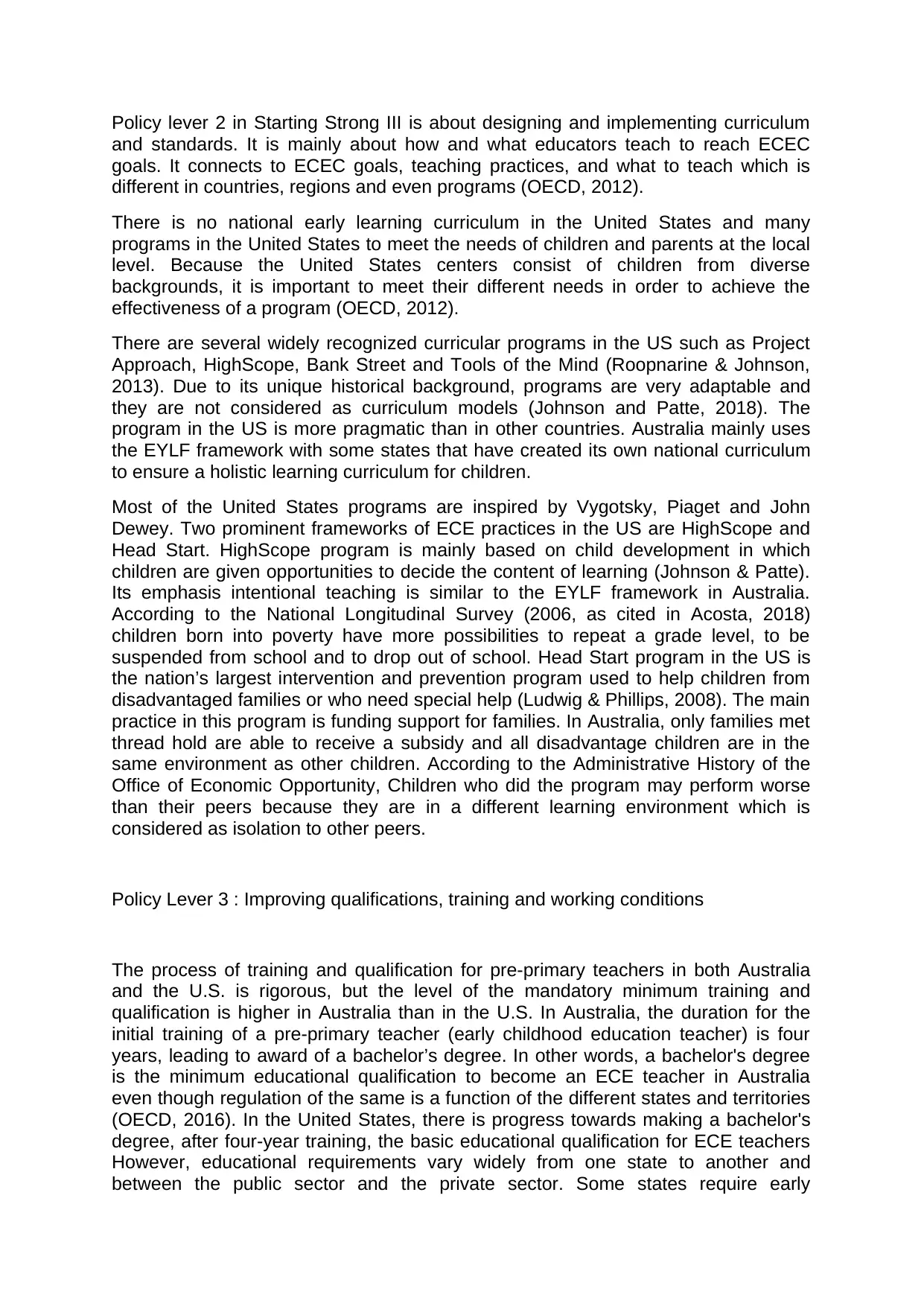
Policy lever 2 in Starting Strong III is about designing and implementing curriculum
and standards. It is mainly about how and what educators teach to reach ECEC
goals. It connects to ECEC goals, teaching practices, and what to teach which is
different in countries, regions and even programs (OECD, 2012).
There is no national early learning curriculum in the United States and many
programs in the United States to meet the needs of children and parents at the local
level. Because the United States centers consist of children from diverse
backgrounds, it is important to meet their different needs in order to achieve the
effectiveness of a program (OECD, 2012).
There are several widely recognized curricular programs in the US such as Project
Approach, HighScope, Bank Street and Tools of the Mind (Roopnarine & Johnson,
2013). Due to its unique historical background, programs are very adaptable and
they are not considered as curriculum models (Johnson and Patte, 2018). The
program in the US is more pragmatic than in other countries. Australia mainly uses
the EYLF framework with some states that have created its own national curriculum
to ensure a holistic learning curriculum for children.
Most of the United States programs are inspired by Vygotsky, Piaget and John
Dewey. Two prominent frameworks of ECE practices in the US are HighScope and
Head Start. HighScope program is mainly based on child development in which
children are given opportunities to decide the content of learning (Johnson & Patte).
Its emphasis intentional teaching is similar to the EYLF framework in Australia.
According to the National Longitudinal Survey (2006, as cited in Acosta, 2018)
children born into poverty have more possibilities to repeat a grade level, to be
suspended from school and to drop out of school. Head Start program in the US is
the nation’s largest intervention and prevention program used to help children from
disadvantaged families or who need special help (Ludwig & Phillips, 2008). The main
practice in this program is funding support for families. In Australia, only families met
thread hold are able to receive a subsidy and all disadvantage children are in the
same environment as other children. According to the Administrative History of the
Office of Economic Opportunity, Children who did the program may perform worse
than their peers because they are in a different learning environment which is
considered as isolation to other peers.
Policy Lever 3 : Improving qualifications, training and working conditions
The process of training and qualification for pre-primary teachers in both Australia
and the U.S. is rigorous, but the level of the mandatory minimum training and
qualification is higher in Australia than in the U.S. In Australia, the duration for the
initial training of a pre-primary teacher (early childhood education teacher) is four
years, leading to award of a bachelor’s degree. In other words, a bachelor's degree
is the minimum educational qualification to become an ECE teacher in Australia
even though regulation of the same is a function of the different states and territories
(OECD, 2016). In the United States, there is progress towards making a bachelor's
degree, after four-year training, the basic educational qualification for ECE teachers
However, educational requirements vary widely from one state to another and
between the public sector and the private sector. Some states require early
and standards. It is mainly about how and what educators teach to reach ECEC
goals. It connects to ECEC goals, teaching practices, and what to teach which is
different in countries, regions and even programs (OECD, 2012).
There is no national early learning curriculum in the United States and many
programs in the United States to meet the needs of children and parents at the local
level. Because the United States centers consist of children from diverse
backgrounds, it is important to meet their different needs in order to achieve the
effectiveness of a program (OECD, 2012).
There are several widely recognized curricular programs in the US such as Project
Approach, HighScope, Bank Street and Tools of the Mind (Roopnarine & Johnson,
2013). Due to its unique historical background, programs are very adaptable and
they are not considered as curriculum models (Johnson and Patte, 2018). The
program in the US is more pragmatic than in other countries. Australia mainly uses
the EYLF framework with some states that have created its own national curriculum
to ensure a holistic learning curriculum for children.
Most of the United States programs are inspired by Vygotsky, Piaget and John
Dewey. Two prominent frameworks of ECE practices in the US are HighScope and
Head Start. HighScope program is mainly based on child development in which
children are given opportunities to decide the content of learning (Johnson & Patte).
Its emphasis intentional teaching is similar to the EYLF framework in Australia.
According to the National Longitudinal Survey (2006, as cited in Acosta, 2018)
children born into poverty have more possibilities to repeat a grade level, to be
suspended from school and to drop out of school. Head Start program in the US is
the nation’s largest intervention and prevention program used to help children from
disadvantaged families or who need special help (Ludwig & Phillips, 2008). The main
practice in this program is funding support for families. In Australia, only families met
thread hold are able to receive a subsidy and all disadvantage children are in the
same environment as other children. According to the Administrative History of the
Office of Economic Opportunity, Children who did the program may perform worse
than their peers because they are in a different learning environment which is
considered as isolation to other peers.
Policy Lever 3 : Improving qualifications, training and working conditions
The process of training and qualification for pre-primary teachers in both Australia
and the U.S. is rigorous, but the level of the mandatory minimum training and
qualification is higher in Australia than in the U.S. In Australia, the duration for the
initial training of a pre-primary teacher (early childhood education teacher) is four
years, leading to award of a bachelor’s degree. In other words, a bachelor's degree
is the minimum educational qualification to become an ECE teacher in Australia
even though regulation of the same is a function of the different states and territories
(OECD, 2016). In the United States, there is progress towards making a bachelor's
degree, after four-year training, the basic educational qualification for ECE teachers
However, educational requirements vary widely from one state to another and
between the public sector and the private sector. Some states require early

childhood teachers to have a bachelor's degree while some do not. Similarly, there is
no requirement for a bachelor's degree in non-public early childhood schools (Cho &
Couse, 2015). The level of initial teacher's training and the duration of the same is
positively correlated with the quality of early childhood education (OECD, 2017).
Thus, from a policy perspective of training and qualifications, Australia is doing better
than the U.S. on the overall.
Both countries have made significant attempts to improve the working
conditions of early childhood teachers. The salaries earned by teachers in both
countries vary according to years of experience. Based on typical qualifications
(bachelor's degree), Australia has a higher beginning statutory salary for early
childhood teachers than the United States. The annual starting statutory salary of an
early childhood educator in Australia in the public sector is about 44,729 USD.
Comparatively, a starting early childhood educator in the United States earns a
yearly salary of 39, 506 USD (OECD, 2018). On the other hand, for 15 years’
experience, teachers in the United States earn more than their Australian
counterparts; 65,728 USD versus 63, 277 USD. The same situation is replicated for
teachers at the top of scale; 72,886 USD for United States versus 65,706 USD for
Australia (OECD, 2018). Therefore, Australia concentrates salary increments in the
early years of teachers' careers unlike the United States where salary increase
happens in the later years. While starting teachers in Australia earn more than U.S.
teachers, the earning capacity of U.S. teachers after attainment of 15 years'
experience is significantly higher than that of their Australian equivalents. A report by
OECD (2017) notes that competitive salaries can help to attract qualified educators.
Literature shows that salaries affect job satisfaction and effectiveness of educators.
In terms of salaries, the U.S. seems to be doing better on average in later career
years while Australia is doing better in early career years.
Other working conditions of early childhood teachers are as equally important
as salaries Notably, heavy workloads and low staff-child ratios expose ECE
practitioners to mental stress. Workload is signified by the number of working hours.
In terms of workload, Australia has done more than the United States to improve the
work-life balance of ECE teachers, hence the quality of teaching. On average, an
Australian ECE teacher works for 886 hours per year compared to 1011 hours for a
U.S. teacher (OECD, 2018). However, Australia leads the United States in terms of
staff-child ratio; about five children per teacher versus 13 children per teacher as per
ISCED 02 (OECD, 2017). A smaller staff-child ratio is desirable because it allows
personalized focus on the needs of individual learners while reducing the amount of
class time required to handle disruptions.
Policy lever 4 : Engaging families and communities
Engaging students is an important aspect of being successful in the classroom.
Some of the policy levels that can be used to ensure proper student engagement.
Student engagement at a micro level involves a great deal of collaboration between
teachers, schools and parents (Thomlinson, 2017). The school measures student
engagement via key school metrics designed to measure the theoretical level of
student engagement including parent contact time, evaluation of successful parent
teacher meetings (Thomlinson, 2017). One of the more common school policies that
is employed is for schools to generate a open line of communication with parents
and students about each other’s clear and precise expectations. It is school policy to
no requirement for a bachelor's degree in non-public early childhood schools (Cho &
Couse, 2015). The level of initial teacher's training and the duration of the same is
positively correlated with the quality of early childhood education (OECD, 2017).
Thus, from a policy perspective of training and qualifications, Australia is doing better
than the U.S. on the overall.
Both countries have made significant attempts to improve the working
conditions of early childhood teachers. The salaries earned by teachers in both
countries vary according to years of experience. Based on typical qualifications
(bachelor's degree), Australia has a higher beginning statutory salary for early
childhood teachers than the United States. The annual starting statutory salary of an
early childhood educator in Australia in the public sector is about 44,729 USD.
Comparatively, a starting early childhood educator in the United States earns a
yearly salary of 39, 506 USD (OECD, 2018). On the other hand, for 15 years’
experience, teachers in the United States earn more than their Australian
counterparts; 65,728 USD versus 63, 277 USD. The same situation is replicated for
teachers at the top of scale; 72,886 USD for United States versus 65,706 USD for
Australia (OECD, 2018). Therefore, Australia concentrates salary increments in the
early years of teachers' careers unlike the United States where salary increase
happens in the later years. While starting teachers in Australia earn more than U.S.
teachers, the earning capacity of U.S. teachers after attainment of 15 years'
experience is significantly higher than that of their Australian equivalents. A report by
OECD (2017) notes that competitive salaries can help to attract qualified educators.
Literature shows that salaries affect job satisfaction and effectiveness of educators.
In terms of salaries, the U.S. seems to be doing better on average in later career
years while Australia is doing better in early career years.
Other working conditions of early childhood teachers are as equally important
as salaries Notably, heavy workloads and low staff-child ratios expose ECE
practitioners to mental stress. Workload is signified by the number of working hours.
In terms of workload, Australia has done more than the United States to improve the
work-life balance of ECE teachers, hence the quality of teaching. On average, an
Australian ECE teacher works for 886 hours per year compared to 1011 hours for a
U.S. teacher (OECD, 2018). However, Australia leads the United States in terms of
staff-child ratio; about five children per teacher versus 13 children per teacher as per
ISCED 02 (OECD, 2017). A smaller staff-child ratio is desirable because it allows
personalized focus on the needs of individual learners while reducing the amount of
class time required to handle disruptions.
Policy lever 4 : Engaging families and communities
Engaging students is an important aspect of being successful in the classroom.
Some of the policy levels that can be used to ensure proper student engagement.
Student engagement at a micro level involves a great deal of collaboration between
teachers, schools and parents (Thomlinson, 2017). The school measures student
engagement via key school metrics designed to measure the theoretical level of
student engagement including parent contact time, evaluation of successful parent
teacher meetings (Thomlinson, 2017). One of the more common school policies that
is employed is for schools to generate a open line of communication with parents
and students about each other’s clear and precise expectations. It is school policy to
⊘ This is a preview!⊘
Do you want full access?
Subscribe today to unlock all pages.

Trusted by 1+ million students worldwide
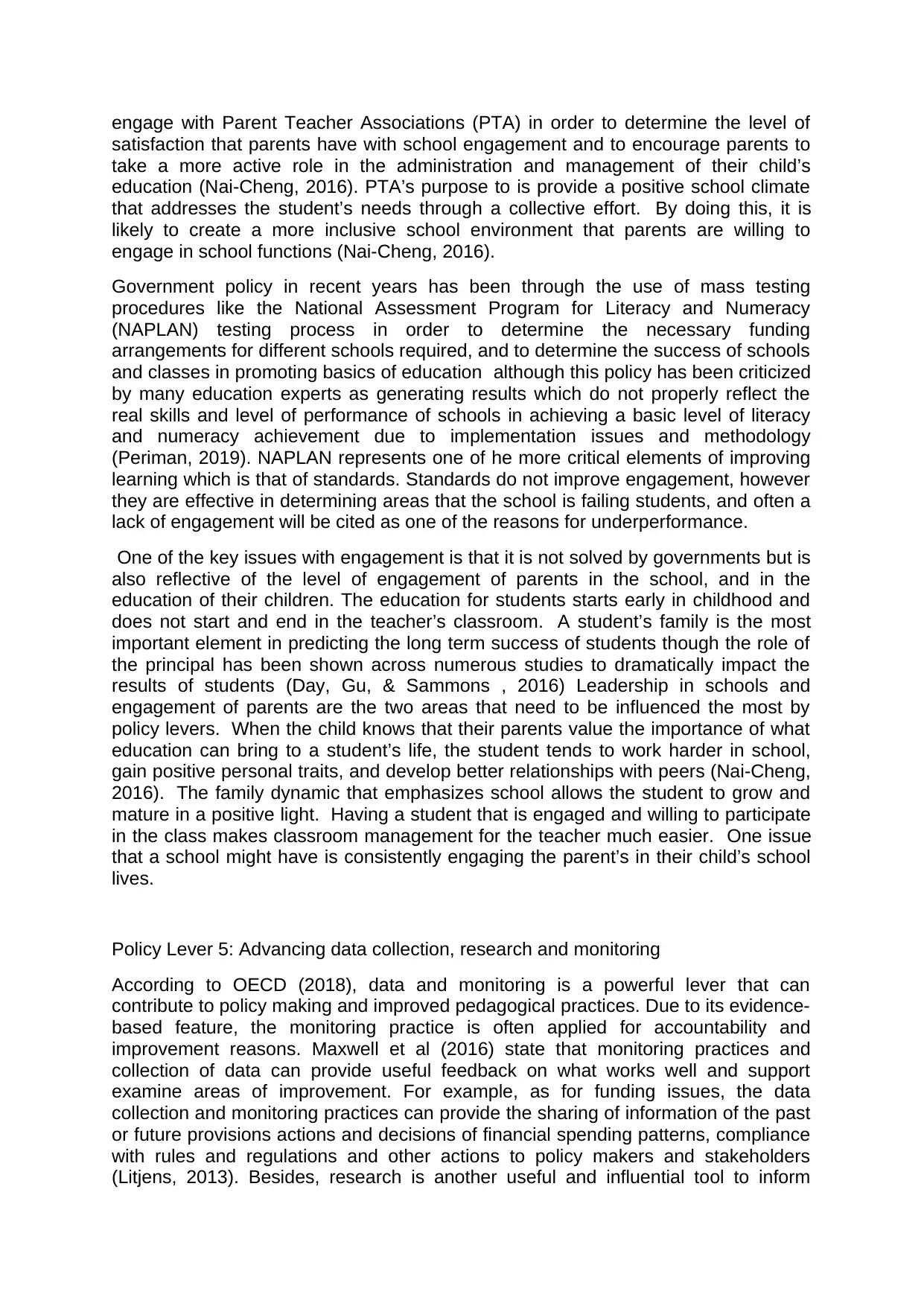
engage with Parent Teacher Associations (PTA) in order to determine the level of
satisfaction that parents have with school engagement and to encourage parents to
take a more active role in the administration and management of their child’s
education (Nai-Cheng, 2016). PTA’s purpose to is provide a positive school climate
that addresses the student’s needs through a collective effort. By doing this, it is
likely to create a more inclusive school environment that parents are willing to
engage in school functions (Nai-Cheng, 2016).
Government policy in recent years has been through the use of mass testing
procedures like the National Assessment Program for Literacy and Numeracy
(NAPLAN) testing process in order to determine the necessary funding
arrangements for different schools required, and to determine the success of schools
and classes in promoting basics of education although this policy has been criticized
by many education experts as generating results which do not properly reflect the
real skills and level of performance of schools in achieving a basic level of literacy
and numeracy achievement due to implementation issues and methodology
(Periman, 2019). NAPLAN represents one of he more critical elements of improving
learning which is that of standards. Standards do not improve engagement, however
they are effective in determining areas that the school is failing students, and often a
lack of engagement will be cited as one of the reasons for underperformance.
One of the key issues with engagement is that it is not solved by governments but is
also reflective of the level of engagement of parents in the school, and in the
education of their children. The education for students starts early in childhood and
does not start and end in the teacher’s classroom. A student’s family is the most
important element in predicting the long term success of students though the role of
the principal has been shown across numerous studies to dramatically impact the
results of students (Day, Gu, & Sammons , 2016) Leadership in schools and
engagement of parents are the two areas that need to be influenced the most by
policy levers. When the child knows that their parents value the importance of what
education can bring to a student’s life, the student tends to work harder in school,
gain positive personal traits, and develop better relationships with peers (Nai-Cheng,
2016). The family dynamic that emphasizes school allows the student to grow and
mature in a positive light. Having a student that is engaged and willing to participate
in the class makes classroom management for the teacher much easier. One issue
that a school might have is consistently engaging the parent’s in their child’s school
lives.
Policy Lever 5: Advancing data collection, research and monitoring
According to OECD (2018), data and monitoring is a powerful lever that can
contribute to policy making and improved pedagogical practices. Due to its evidence-
based feature, the monitoring practice is often applied for accountability and
improvement reasons. Maxwell et al (2016) state that monitoring practices and
collection of data can provide useful feedback on what works well and support
examine areas of improvement. For example, as for funding issues, the data
collection and monitoring practices can provide the sharing of information of the past
or future provisions actions and decisions of financial spending patterns, compliance
with rules and regulations and other actions to policy makers and stakeholders
(Litjens, 2013). Besides, research is another useful and influential tool to inform
satisfaction that parents have with school engagement and to encourage parents to
take a more active role in the administration and management of their child’s
education (Nai-Cheng, 2016). PTA’s purpose to is provide a positive school climate
that addresses the student’s needs through a collective effort. By doing this, it is
likely to create a more inclusive school environment that parents are willing to
engage in school functions (Nai-Cheng, 2016).
Government policy in recent years has been through the use of mass testing
procedures like the National Assessment Program for Literacy and Numeracy
(NAPLAN) testing process in order to determine the necessary funding
arrangements for different schools required, and to determine the success of schools
and classes in promoting basics of education although this policy has been criticized
by many education experts as generating results which do not properly reflect the
real skills and level of performance of schools in achieving a basic level of literacy
and numeracy achievement due to implementation issues and methodology
(Periman, 2019). NAPLAN represents one of he more critical elements of improving
learning which is that of standards. Standards do not improve engagement, however
they are effective in determining areas that the school is failing students, and often a
lack of engagement will be cited as one of the reasons for underperformance.
One of the key issues with engagement is that it is not solved by governments but is
also reflective of the level of engagement of parents in the school, and in the
education of their children. The education for students starts early in childhood and
does not start and end in the teacher’s classroom. A student’s family is the most
important element in predicting the long term success of students though the role of
the principal has been shown across numerous studies to dramatically impact the
results of students (Day, Gu, & Sammons , 2016) Leadership in schools and
engagement of parents are the two areas that need to be influenced the most by
policy levers. When the child knows that their parents value the importance of what
education can bring to a student’s life, the student tends to work harder in school,
gain positive personal traits, and develop better relationships with peers (Nai-Cheng,
2016). The family dynamic that emphasizes school allows the student to grow and
mature in a positive light. Having a student that is engaged and willing to participate
in the class makes classroom management for the teacher much easier. One issue
that a school might have is consistently engaging the parent’s in their child’s school
lives.
Policy Lever 5: Advancing data collection, research and monitoring
According to OECD (2018), data and monitoring is a powerful lever that can
contribute to policy making and improved pedagogical practices. Due to its evidence-
based feature, the monitoring practice is often applied for accountability and
improvement reasons. Maxwell et al (2016) state that monitoring practices and
collection of data can provide useful feedback on what works well and support
examine areas of improvement. For example, as for funding issues, the data
collection and monitoring practices can provide the sharing of information of the past
or future provisions actions and decisions of financial spending patterns, compliance
with rules and regulations and other actions to policy makers and stakeholders
(Litjens, 2013). Besides, research is another useful and influential tool to inform
Paraphrase This Document
Need a fresh take? Get an instant paraphrase of this document with our AI Paraphraser
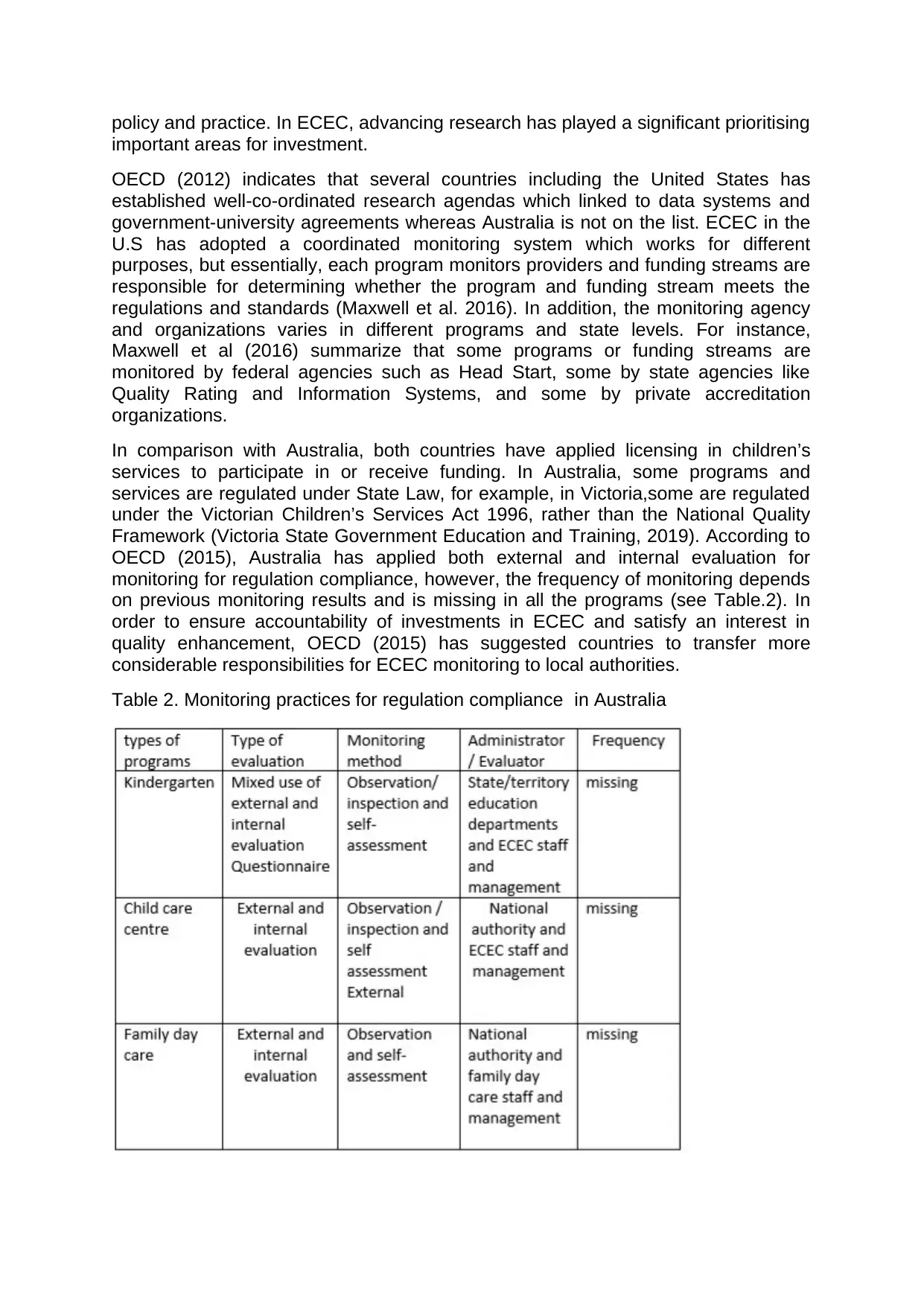
policy and practice. In ECEC, advancing research has played a significant prioritising
important areas for investment.
OECD (2012) indicates that several countries including the United States has
established well-co-ordinated research agendas which linked to data systems and
government-university agreements whereas Australia is not on the list. ECEC in the
U.S has adopted a coordinated monitoring system which works for different
purposes, but essentially, each program monitors providers and funding streams are
responsible for determining whether the program and funding stream meets the
regulations and standards (Maxwell et al. 2016). In addition, the monitoring agency
and organizations varies in different programs and state levels. For instance,
Maxwell et al (2016) summarize that some programs or funding streams are
monitored by federal agencies such as Head Start, some by state agencies like
Quality Rating and Information Systems, and some by private accreditation
organizations.
In comparison with Australia, both countries have applied licensing in children’s
services to participate in or receive funding. In Australia, some programs and
services are regulated under State Law, for example, in Victoria,some are regulated
under the Victorian Children’s Services Act 1996, rather than the National Quality
Framework (Victoria State Government Education and Training, 2019). According to
OECD (2015), Australia has applied both external and internal evaluation for
monitoring for regulation compliance, however, the frequency of monitoring depends
on previous monitoring results and is missing in all the programs (see Table.2). In
order to ensure accountability of investments in ECEC and satisfy an interest in
quality enhancement, OECD (2015) has suggested countries to transfer more
considerable responsibilities for ECEC monitoring to local authorities.
Table 2. Monitoring practices for regulation compliance in Australia
important areas for investment.
OECD (2012) indicates that several countries including the United States has
established well-co-ordinated research agendas which linked to data systems and
government-university agreements whereas Australia is not on the list. ECEC in the
U.S has adopted a coordinated monitoring system which works for different
purposes, but essentially, each program monitors providers and funding streams are
responsible for determining whether the program and funding stream meets the
regulations and standards (Maxwell et al. 2016). In addition, the monitoring agency
and organizations varies in different programs and state levels. For instance,
Maxwell et al (2016) summarize that some programs or funding streams are
monitored by federal agencies such as Head Start, some by state agencies like
Quality Rating and Information Systems, and some by private accreditation
organizations.
In comparison with Australia, both countries have applied licensing in children’s
services to participate in or receive funding. In Australia, some programs and
services are regulated under State Law, for example, in Victoria,some are regulated
under the Victorian Children’s Services Act 1996, rather than the National Quality
Framework (Victoria State Government Education and Training, 2019). According to
OECD (2015), Australia has applied both external and internal evaluation for
monitoring for regulation compliance, however, the frequency of monitoring depends
on previous monitoring results and is missing in all the programs (see Table.2). In
order to ensure accountability of investments in ECEC and satisfy an interest in
quality enhancement, OECD (2015) has suggested countries to transfer more
considerable responsibilities for ECEC monitoring to local authorities.
Table 2. Monitoring practices for regulation compliance in Australia
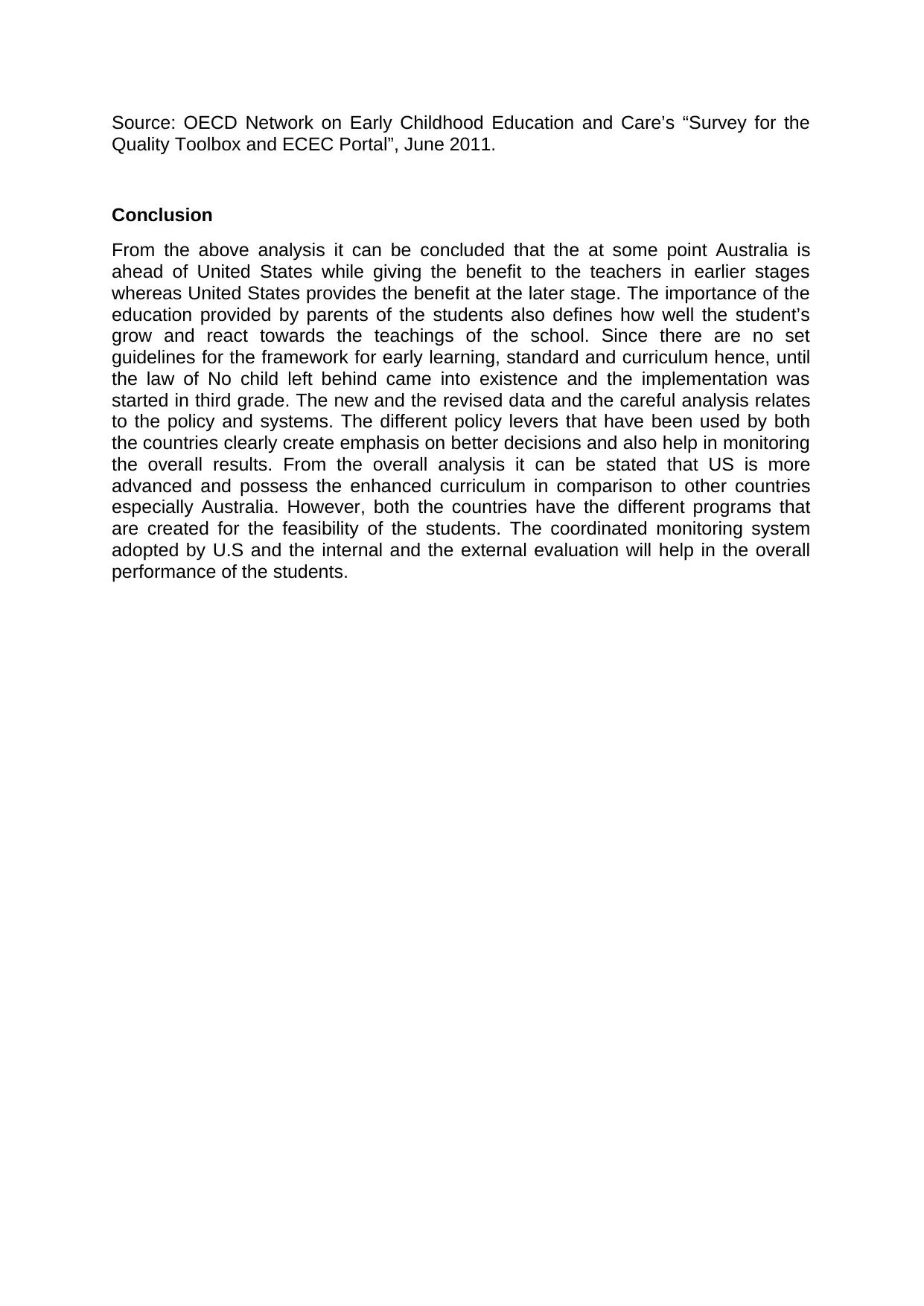
Source: OECD Network on Early Childhood Education and Care’s “Survey for the
Quality Toolbox and ECEC Portal”, June 2011.
Conclusion
From the above analysis it can be concluded that the at some point Australia is
ahead of United States while giving the benefit to the teachers in earlier stages
whereas United States provides the benefit at the later stage. The importance of the
education provided by parents of the students also defines how well the student’s
grow and react towards the teachings of the school. Since there are no set
guidelines for the framework for early learning, standard and curriculum hence, until
the law of No child left behind came into existence and the implementation was
started in third grade. The new and the revised data and the careful analysis relates
to the policy and systems. The different policy levers that have been used by both
the countries clearly create emphasis on better decisions and also help in monitoring
the overall results. From the overall analysis it can be stated that US is more
advanced and possess the enhanced curriculum in comparison to other countries
especially Australia. However, both the countries have the different programs that
are created for the feasibility of the students. The coordinated monitoring system
adopted by U.S and the internal and the external evaluation will help in the overall
performance of the students.
Quality Toolbox and ECEC Portal”, June 2011.
Conclusion
From the above analysis it can be concluded that the at some point Australia is
ahead of United States while giving the benefit to the teachers in earlier stages
whereas United States provides the benefit at the later stage. The importance of the
education provided by parents of the students also defines how well the student’s
grow and react towards the teachings of the school. Since there are no set
guidelines for the framework for early learning, standard and curriculum hence, until
the law of No child left behind came into existence and the implementation was
started in third grade. The new and the revised data and the careful analysis relates
to the policy and systems. The different policy levers that have been used by both
the countries clearly create emphasis on better decisions and also help in monitoring
the overall results. From the overall analysis it can be stated that US is more
advanced and possess the enhanced curriculum in comparison to other countries
especially Australia. However, both the countries have the different programs that
are created for the feasibility of the students. The coordinated monitoring system
adopted by U.S and the internal and the external evaluation will help in the overall
performance of the students.
⊘ This is a preview!⊘
Do you want full access?
Subscribe today to unlock all pages.

Trusted by 1+ million students worldwide
1 out of 9
Your All-in-One AI-Powered Toolkit for Academic Success.
+13062052269
info@desklib.com
Available 24*7 on WhatsApp / Email
![[object Object]](/_next/static/media/star-bottom.7253800d.svg)
Unlock your academic potential
Copyright © 2020–2025 A2Z Services. All Rights Reserved. Developed and managed by ZUCOL.


